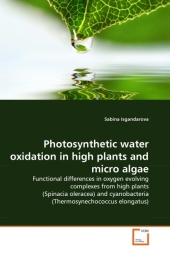 Neuerscheinungen 2010Stand: 2020-01-07 |
Schnellsuche
ISBN/Stichwort/Autor
|
Herderstraße 10
10625 Berlin
Tel.: 030 315 714 16
Fax 030 315 714 14
info@buchspektrum.de |

Sabina Isgandarova
Photosynthetic water oxidation in high plants and micro algae
Functional differences in oxygen evolving complexes from high plants (Spinacia oleracea) and cyanobacteria (Thermosynechococcus elongatus)
2010. 164 S.
Verlag/Jahr: VDM VERLAG DR. MÜLLER 2010
ISBN: 3-639-29906-X (363929906X)
Neue ISBN: 978-3-639-29906-9 (9783639299069)
Preis und Lieferzeit: Bitte klicken
This book will bring you closer towards understanding how photosynthetic oxygen evolution works in high plants and micro algae, or cyanobacteria. To the time when this work was done, information on photosynthesis was largely based on experimental results obtained from studies on high plants, mainly spinach. Yet no crystal structure of photosystem 2 was available from high plants. In 2001, Dr. Zouni and co-workers from TU-Berlin had reported a crystal structure of photosystem 2 obtained at resolution 3.8 from a thermophilic cyanobacteria Thermosynechococcus elongatus. Thus an important question to answer was: how similar photosynthetic water oxidation mechanisms are in high plants and cyanobacteria? The author used Joliot-type electrode to produce and afterward to compare flash induced oxygen evolution patterns from cyanobacteria and high plants to understand functional similarities and differences in oxygen evolving complex (OEC) of photosystem 2. The author also analyzed effects of H/D isotope exchange on reactions of OEC under different pL and temperature. The author also went beyond the classic Kok model to characterize super -reduced states of OEC.
Originally from Baku, Azerbaijan. Received PhD degree from Technical University of Berlin, Germany with Dr. Johannes Messinger. Currently residing in Alberta, Canada and interested in biological CO2 sequestration as an alternative energy source.


